Letter Includes Digital Artwork Created to Celebrate Historic Events
Pope Francis will issue a formal letter on climate change this summer, followed by a visit to the United States to address a joint session of the U.S. Congress. Honoring the Future sees these historic events as an opportunity for all Americans to pause and consider what they can do to respond to the threat of climate change in their own lives and in their community.
Honoring the Future is collecting signatures on a letter to the Pope that recognizes the importance of his actions and commits the signers to approach his message with an open mind. The letter includes an original artwork that celebrates these historic events.
In September, 2015, the Pope will travel to Washington DC. He will become the first Pope ever to address a joint session of Congress. He will also travel to Philadelphia and to New York City, where he will speak to the United Nations in anticipation of international negotiations on climate change scheduled to take place in Paris this December.
Before his trip, the Pope plans to issue a rare “encyclical” – a formal letter of guidance to the whole church – on climate change. This will be the first encyclical to focus primarily on climate change and human responsibility for the environment
Honoring the Future’s letter to the Pope expresses gratitude for the Pope’s leadership on climate change and voices hope Americans will listen “with open minds, generous hearts, and a willingness to honor our responsibility to care lovingly for the earth we leave our children, grandchildren, and generations to come.”
The letter opens with a digital art image created by Miami artist Xavier Cortada to celebrate these historic events.

Xavier Cortada, “ΙΧΘΥΣ (Ichthys),” digital art, 2015. Artwork created to welcome Pope Francis’ climate change message and U.S. visit. ©2015 Xavier Cortada
“The opening artwork fittingly weaves together two important threads of church history: the beginning of the church and the modern era,” says Honoring the Future project director Fran Dubrowski.
The digital image, entitled “ΙΧΘΥΣ (Ichthys)” from the Greek word for fish, refers to a stylized symbol of two arcs intersecting to form a profile of a fish. Cortada explains this symbol was used by the first church members during a time of persecution “to communicate with one another, build fellowship, and spread their ideas.” Cortada intends to evoke both their “sense of urgency” and the strength they found in unifying purpose as models for climate action: “As a global community we must come together as the first Christians did and think of the greater good,” Cortada says.
The image of fish also draws on the U.S. Conference of Catholic Bishops’ Statement on climate change, approved by the full body of U.S. Catholic bishops in June, 2001. The statement cites a passage from the Book of Psalms. The full passage reads:
The earth is the Lord’s and all it holds
The world and those who live there.
For God founded it on the seas and established it over the rivers.
Ps 24:1-2
The bishops concluded: “We believe our response to global climate change should be a sign of our respect for God’s creation…. At its core, global climate change … is about the future of God’s creation and the one human family…. It is about our human stewardship of God’s creation and our responsibility to those who come after us.”
After carefully reviewing the science in 2001, the bishops determined: “What we already know … dictates taking mitigating or preventative action.” They encouraged the laity to become informed, reconsider lifestyle choices, conserve energy, prevent pollution, live more simply, and preserve and protect the planet for our children and generations yet unborn.
“Today, many Catholics – and other Americans – are unaware of this call to action,” said Dubrowski. “The Pope’s visit provides an opportunity to refocus the United States’ nearly 80 million Catholics and all people of good will on the urgent need to act on climate change.”
To add your name to the letter, click here.


